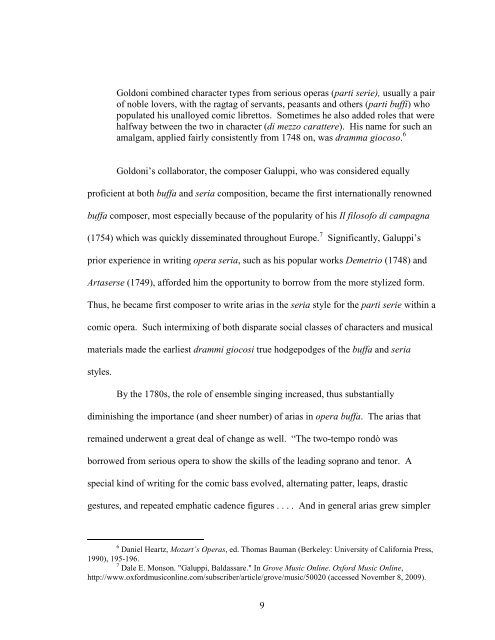HINSON, DANIEL ROSS, DMA Are You Serious? - The University of ...
HINSON, DANIEL ROSS, DMA Are You Serious? - The University of ...
HINSON, DANIEL ROSS, DMA Are You Serious? - The University of ...
You also want an ePaper? Increase the reach of your titles
YUMPU automatically turns print PDFs into web optimized ePapers that Google loves.
Goldoni combined character types from serious operas (parti serie), usually a pair<br />
<strong>of</strong> noble lovers, with the ragtag <strong>of</strong> servants, peasants and others (parti buffi) who<br />
populated his unalloyed comic librettos. Sometimes he also added roles that were<br />
halfway between the two in character (di mezzo carattere). His name for such an<br />
amalgam, applied fairly consistently from 1748 on, was dramma giocoso. 6<br />
Goldoni’s collaborator, the composer Galuppi, who was considered equally<br />
pr<strong>of</strong>icient at both buffa and seria composition, became the first internationally renowned<br />
buffa composer, most especially because <strong>of</strong> the popularity <strong>of</strong> his Il filos<strong>of</strong>o di campagna<br />
(1754) which was quickly disseminated throughout Europe. 7 Significantly, Galuppi’s<br />
prior experience in writing opera seria, such as his popular works Demetrio (1748) and<br />
Artaserse (1749), afforded him the opportunity to borrow from the more stylized form.<br />
Thus, he became first composer to write arias in the seria style for the parti serie within a<br />
comic opera. Such intermixing <strong>of</strong> both disparate social classes <strong>of</strong> characters and musical<br />
materials made the earliest drammi giocosi true hodgepodges <strong>of</strong> the buffa and seria<br />
styles.<br />
By the 1780s, the role <strong>of</strong> ensemble singing increased, thus substantially<br />
diminishing the importance (and sheer number) <strong>of</strong> arias in opera buffa. <strong>The</strong> arias that<br />
remained underwent a great deal <strong>of</strong> change as well. “<strong>The</strong> two-tempo rondò was<br />
borrowed from serious opera to show the skills <strong>of</strong> the leading soprano and tenor. A<br />
special kind <strong>of</strong> writing for the comic bass evolved, alternating patter, leaps, drastic<br />
gestures, and repeated emphatic cadence figures . . . . And in general arias grew simpler<br />
6<br />
Daniel Heartz, Mozart’s Operas, ed. Thomas Bauman (Berkeley: <strong>University</strong> <strong>of</strong> California Press,<br />
1990), 195-196.<br />
7<br />
Dale E. Monson. "Galuppi, Baldassare." In Grove Music Online. Oxford Music Online,<br />
http://www.oxfordmusiconline.com/subscriber/article/grove/music/50020 (accessed November 8, 2009).<br />
9

















